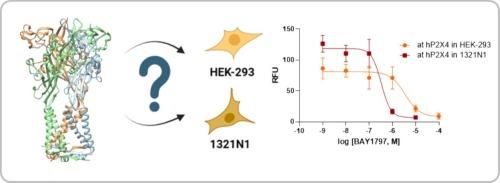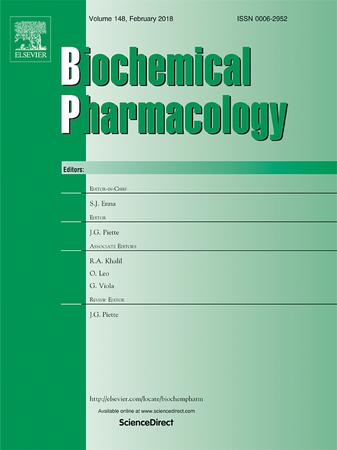探索 P2X 受体的活性:从细胞影响到电生理学剖析的旅程。
IF 5.3
2区 医学
Q1 PHARMACOLOGY & PHARMACY
引用次数: 0
摘要
体外药理学检测的开发依赖于创建过表达相关目标蛋白的转基因细胞系。然而,宿主细胞系的选择会对实验结果产生重大影响。本研究通过细胞实验和先进的电生理技术,探索 P2X7 和 P2X4 受体调节剂的功能特性。研究系统地探讨了不同宿主细胞系(HEK-293、HEK-293FT 和 1321N1)对以人类和鼠类 P2X4 和 P2X7 受体为靶标的参考激动剂和拮抗剂活性的影响,强调了宿主细胞对实验结果的重要影响。在研究人 P2X4 受体时,1321N1 细胞系被确定为首选宿主细胞系,因为它具有更一致的激动剂活性、拮抗剂效力和更稳定的检测信号窗。此外,该研究还建立了一种贴片钳协议,可重复记录离体人类 CD4+ T 细胞的 ATP 介导的内向电流,揭示了 P2X7 和 P2X4 受体对免疫细胞调控的关键作用,使它们成为治疗炎症性疾病的有前途的治疗靶点。本文章由计算机程序翻译,如有差异,请以英文原文为准。

Exploring P2X receptor activity: A journey from cellular impact to electrophysiological profiling
The development of in vitro pharmacological assays relies on creating genetically modified cell lines that overexpress the target protein of interest. However, the choice of the host cell line can significantly impact the experimental outcomes. This study explores the functional characterization of P2X7 and P2X4 receptor modulators through cellular assays and advanced electrophysiological techniques. The influence of different host cell lines (HEK-293, HEK-293FT, and 1321N1) on the activity of reference agonists and antagonists targeting human and murine P2X4 and P2X7 receptors was systematically investigated, highlighting the significant impact of the host cell on experimental results. The 1321N1 cell line was identified as the preferred host cell line when investigating the human P2X4 receptor due to more consistent agonist activities, antagonist potencies, and a more stable assay signal window. Furthermore, a patch-clamp protocol that allows for the repetitive recording of ATP-mediated inward currents from isolated human CD4+ T-cells was established, revealing that both P2X7 and P2X4 receptors are crucial for immune cell regulation, positioning them as promising therapeutic targets for managing inflammatory disorders.
求助全文
通过发布文献求助,成功后即可免费获取论文全文。
去求助
来源期刊

Biochemical pharmacology
医学-药学
CiteScore
10.30
自引率
1.70%
发文量
420
审稿时长
17 days
期刊介绍:
Biochemical Pharmacology publishes original research findings, Commentaries and review articles related to the elucidation of cellular and tissue function(s) at the biochemical and molecular levels, the modification of cellular phenotype(s) by genetic, transcriptional/translational or drug/compound-induced modifications, as well as the pharmacodynamics and pharmacokinetics of xenobiotics and drugs, the latter including both small molecules and biologics.
The journal''s target audience includes scientists engaged in the identification and study of the mechanisms of action of xenobiotics, biologics and drugs and in the drug discovery and development process.
All areas of cellular biology and cellular, tissue/organ and whole animal pharmacology fall within the scope of the journal. Drug classes covered include anti-infectives, anti-inflammatory agents, chemotherapeutics, cardiovascular, endocrinological, immunological, metabolic, neurological and psychiatric drugs, as well as research on drug metabolism and kinetics. While medicinal chemistry is a topic of complimentary interest, manuscripts in this area must contain sufficient biological data to characterize pharmacologically the compounds reported. Submissions describing work focused predominately on chemical synthesis and molecular modeling will not be considered for review.
While particular emphasis is placed on reporting the results of molecular and biochemical studies, research involving the use of tissue and animal models of human pathophysiology and toxicology is of interest to the extent that it helps define drug mechanisms of action, safety and efficacy.
 求助内容:
求助内容: 应助结果提醒方式:
应助结果提醒方式:


